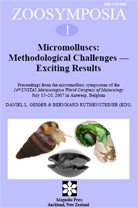Type: Article
Published: 2008-07-25
Page range: 1–13
Abstract views: 456
PDF downloaded: 1
New techniques yield new insights on the basic biology of living microgastropods
light traps
emergence traps
infauna
interstitial fauna
stygofauna
rafting
drifting
diel vertical migrations

